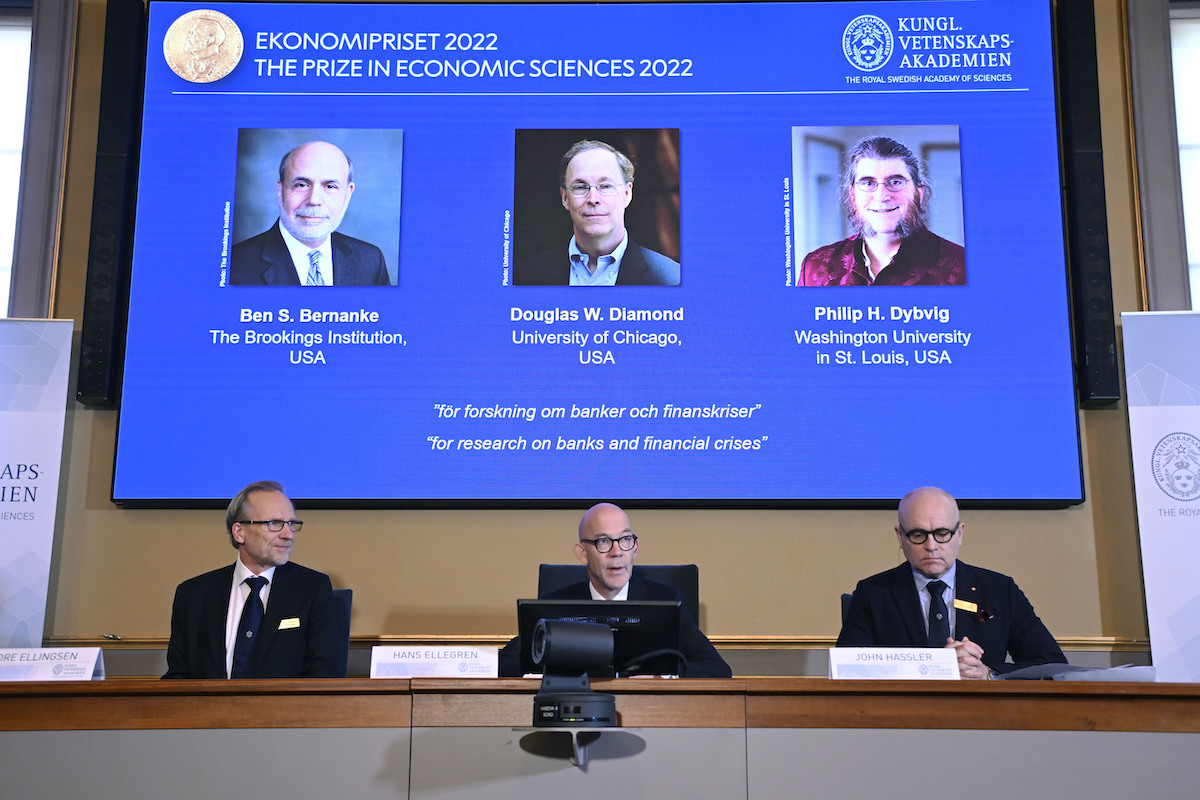Earlier this month, Ben Bernanke, Douglas Diamond, and Philip Dybvig were awarded the Bank of Sweden Prize in Economic Sciences in memory of Alfred Nobel. Bernanke, Diamond, and Dybvig were honored for their many contributions to our shared understanding of both the role of banking and banking failures.
If that award name strikes you as being longer than the names of the prizes awarded in other Nobel categories, such as literature, physics, and peace, it should. All the other prizes are funded from the accrual of interest on the initial endowment made possible by Alfred Nobel and were initiated in 1901. The newer prize in “economic sciences,” as the name suggests, is funded by the Bank of Sweden and wasn’t awarded until 1969.
In most years, the economics prize is awarded to just one or two recipients. It has been shared by three economists fewer than 10 times since 1969—the maximum number of recipients permitted in a single year. In a year in which the prize is shared, the award—10 million Swedish krona—is divided equally among recipients. On a side note, the prize normally works out to roughly US$1 million, but due to the current strength of the dollar on foreign exchange markets, the three new laureates will be sharing about US$883,000. Ten million Swedish krona just doesn’t buy what it used to.
By now you’ve likely read lots of news coverage of the recipients and their work. To summarize, this year’s awardees received the prize because they helped us understand even better why banking persists despite the very real possibility of banking failures. While we sometimes take banks for granted, banks haven’t always been as reliable as they are today. The new laureates help us better understand why we need banks, why they need us, and why panics and crises imperil banking institutions and their depositors.
To understand the work of the new laureates, it’s helpful to think carefully about the business model of banks. In a sense, banks function as any other producer of a good or service: They transform productive inputs into finished goods and presumably pay less for the inputs than they charge for their outputs. But banks are not buying the kinds of inputs we normally think of; they’re not buying iron, coal, and limestone for the purpose of refining and selling steel products, for example. Instead, banks purchase unique inputs in their production process: They pay for the use of our money when we make deposits at their counters and ATMs, and even through direct deposits. And they pay us, in the form of interest, for the use of our money when making loans to their other customers—borrowers. And the banking business model works, in part, because banks are able to charge their loan clients a higher rate of interest than they pay to their depositors. Otherwise, the business model wouldn’t work at all.
This leads to an obvious question that we rarely consider: If banks are merely serving an intermediary role between savers and borrowers, why don’t savers “cut out the middleman” and invest their money directly with the firms who are ultimately borrowing the savers’ money in the first place? Why should households settle for a lowball rate of interest when they could make loans directly to businesses at a higher rate of interest than banks pay on deposits?
The answer lies in the fact that when households deposit their savings at commercial banks, the savers are receiving benefits beyond the lowball rate of interest they are paid. First, even if banks were to pay no rate of interest at all, the savers receive the appearance of security for their hard-earned savings that it’s difficult for them to replicate at home. We put our money in banks precisely because we see such institutions as safer parking spots for cash than our mattresses or piggy banks.
But for savers to buy into the idea that a bank is a safer place for their money than their houses, banks must persuade savers that this is, in fact, the case. This is why, before the advent of things like federal deposit insurance, banks had to engage in costly signaling to persuade savers that if they left their money at a bank this week, both the bank and the money would still be there next week. Banking doesn’t work well when savers are nervous that the bankers will skip town with the money.
It’s likely that you have visited the original office of a historic downtown bank, whether in a big city or even in a small town. These banks often look similar to the bank depicted in the movie Mary Poppins, though possibly on a less grand scale. The most distinctive feature of such banks usually lies in how expensive they must have been to construct: marble columns and floors, hand-carved wooden rails, and even gold inlay in the arches and ceilings. Banks didn’t spend all that money for fun; they were built that way to demonstrate that they intended to be there again tomorrow, and also to give the appearance of prosperity and security. A shady, fly-by-night bank would never make such an investment if it planned to abscond with your money the next day. And you likely recall from such banks their most prominent feature that usually served as the centerpiece of the main hall: a massive safe. Again, banks were investing in signaling to potential depositors that their funds would be safer in banks’ hands than in their own.
But perceived security isn’t the only benefit savers receive from banks. Savers also benefit from the credit-screening function that banks provide before making a loan, and ongoing monitoring of those loans once initiated. Were it not for banks, we’d all need to screen the people we were thinking about loaning our money to. In addition, we’d need to find borrowers who were willing to accept the $50 Christmas money we got from Aunt Carol as a loan. But because of banks, the credit screening is done on our behalf already, because loans are the primary asset held by any bank. So the quality of a bank’s assets is only as good as the likelihood their borrowers don’t default. And banks also give savers immediate diversification, because that $50 of Christmas money gets lent in bits and pieces to all the bank’s commercial borrowers. Your $50 isn’t in one basket; it’s in hundreds. And you can turn up and withdraw some or all of it any time you want; you can’t do that when you loan a plumber $50 for six months.
These functions summarize the legacy of Diamond and Dybvig. As the official press release states, they demonstrated that “by acting as intermediaries that accept deposits from many savers, banks can allow depositors to access their money when they wish, while also offering long-term loans to borrowers.”
And what of the contributions of this year’s third laureate, Ben Bernanke? While Diamond and Dybvig helped us understand why we have banks and why they persist over time, Bernanke considered the challenge of bank failures: why they happen and what might be done about them from a policy perspective.
As we have already suggested, banks make money by accepting deposits through one window, then lending out those same deposits to borrowers through another window—which means that most of the time banks have little incentive to keep cash on hand beyond what is required to address depositors’ likely withdrawal demands. But while banks have strong incentives to voluntarily hold enough to address anticipated liquidity needs of depositors, and also to loan only to credit-worthy borrowers, things get tricky when either depositors’ withdrawal demands grow larger than anticipated or loan clients default on their loans. Either of these sows the seeds of bank panics and bank runs, and you have likely seen cinematic portrayals in both Mary Poppins and It’s a Wonderful Life when there is a run at the Bailey Building & Loan.
As outlined above, banks have extremely strong incentives to diversify among many high-quality borrowers and, when they do so, they simultaneously perform valuable functions for their depositors. Yet even the best-managed banks cannot protect against every possible bank run. When depositors lose confidence in a bank, they want their money back—and now. Thus, just the fear of a bank run can, in fact, create a bank run. And U.S. history is full of examples of “contagion”: when a panic at one bank causes a crisis of confidence in other banks, too. Bernanke explored the nature of such historic episodes and how they were related to the business cycle. Conventional wisdom suggests that recessions lead to bank panics, but Bernanke has argued almost the opposite: that bank panics cause recessions or, at least, make them worse. When banks go belly up due to a panic, society loses both the banks’ ability to serve the banking public as well as the banks’ accumulated knowledge about the quality of their borrowers. And a reduction in such capacity and information sets back the broader economy.
Of course, the fact that banks sometimes fail always leads to suggestions that the remedy lies in more regulation. This was certainly the prescription of Dodd-Frank after the global financial crisis (GFC) that took down Bear-Stearns but not others deemed “too big to fail.”
But sometimes less is more.
For example, the eventual collapse of the “Glass-Steagall wall” made it possible for banks to finally engage in interstate banking so they could make loans to all kinds of businesses, regions, and industries. In the past, Glass-Steagall made it impossible for banks to lend beyond their own state’s borders, which meant that if a given state’s economy fell into financial trouble, then that state’s banks would be imperiled, too, due to lack of diversification in their loan portfolios. And as we have seen from the GFC, sometimes regulations incite bad behavior when they encourage banks to take on greater risks if they know they are likely to be bailed out if they mess up.
Banks provide a valuable service to society. And they persist because they have strong incentives to manage their depositors’ funds as responsibly as possible because banks’ loans are their assets: Banks want to be repaid as much as their depositors do.
There may be a potential role for regulation in banking but, like anything else, regulatory power should be invoked only when it actually improves on existing regulatory structure. And sometimes self-regulation proves stronger than what is externally imposed. To the extent that the three Nobel laureates helped us understand this all a little better, we should be grateful.

